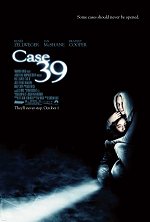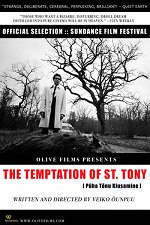 |
|
At The Picture Show
|
February 2011
Fall/Winter rewind
A rundown of a few films that fell through IGMS' cracks

Case 39
Paramount Pictures
Director: Christian Alvart
Screenplay: Ray Wright
Starring: Renee Zellweger, Jodelle Ferland, Ian McShane, Bradley Cooper, Callum Keith
Rennie, Kerry O'Malley and Adrian Lester
Rated R / 1 hour, 49 minutes

 (out of four)
(out of four)
A lot must have been chopped out of Case 39 before the filmmakers arrived at the final cut.
That, or they never really understood what was most important about the story in the first place.
The film centers around a social worker, a seemingly innocent and tormented little girl, and the
destruction that seems to follow her wherever she goes. When we first see Lillith (Jodelle
Ferland), it is as a victim of terrible child abuse at the hands of her parents (Callum Keith Rennie
and Kerry O'Malley), who attempt to toss her in the oven and burn her alive.
Enter Emily Jenkins (Renee Zellweger), who has taken Lillith's case and formed something of a
bond with her, and who rescues her just in the nick of time. OK, pause it right there. The bond I
just mentioned - the emotional connection between Lillith and Emily - that is the meat of the
film. Or should be, anyway. Nothing else works the way it should if that isn't firmly and
carefully established beforehand.
 And so naturally the film glosses over it. As Lillith convinces
Emily to take her in as her foster parent, the film fast-tracks through the process, pausing for the
occasional scene where the two lovingly embrace - without first making sure we'll actually be
convinced about the genuineness of such a gesture. They've barely spoken - really, little more
than one brief moment at a water fountain - and suddenly the film is trying to convince us that
the two are ever so close.
And so naturally the film glosses over it. As Lillith convinces
Emily to take her in as her foster parent, the film fast-tracks through the process, pausing for the
occasional scene where the two lovingly embrace - without first making sure we'll actually be
convinced about the genuineness of such a gesture. They've barely spoken - really, little more
than one brief moment at a water fountain - and suddenly the film is trying to convince us that
the two are ever so close.
Considering the rest of the movie centers around the gradual fracturing of that bond - as Emily
develops unsettling suspicions about the true nature of her new surrogate daughter - you'd think
they'd want to sell us on the relationship aspect first, before jumping right ahead to the scary
stuff.
But Case 39 establishes neither credible character dynamics nor the comfort zone we need in
order to be truly disturbed - or even interested, for that matter - when things start to go awry.
Of course, the film's inability to provide meaningful context is matched by Renee Zellweger's
inability to convince us of anything genuine. She doesn't seem like all that good a social worker,
but the film tells us she is. She doesn't seem all that affectionate toward Lillith, but the film tells
us she is. And her "scared" face . . . well, it's positively B-movie-esque.
But maybe she's beside the point. The film gave her too little to work with for her to be blamed
for its failures. When ultimately Case 39 comes down to adult-vs.-evil child, nothing we see ever
feels like palpable fear or terror. It feels like plot convenience. Now your surrogate daughter is
evil! Act scared! It never seems like it's coming from anyplace but the mechanical workings of a
bad screenplay.

The Temptation of St. Tony
Olive Films
Director: Veiko ’unpuu
Screenplay: Veiko ’unpuu
Starring: Taavi Eelmaa, Ravshana Kurkova, Tiina Tauraite, Sten Ljunggren, Denis Lavant,
Hendrik Toompere Jr. and Katariina Lauk
Rated R / 1 hour, 50 minutes



 (out of four)
(out of four)
As the credits scrolled at the conclusion of The Temptation of St. Tony, a pair of names stood out
in the "special thanks" section - Luis Buñuel and Pier Paolo Pasolini. The acknowledgment
should have come as no great surprise, the influence of both filmmakers having made itself
known throughout - Pasolini in the brilliantly grotesque, even aberrant visual details, Buñuel in
the deadpan absurdity of its surrealist internal logic. (And, ya know, all the Catholic stuff.)
If what I just said wasn't indication enough already, let me make clear that it would be virtually
impossible to explain what the film is like simply by describing its sequence of events. To be
honest, I think that's true of any film - but especially one like this, which is built on its images
and sound design more than anything else.
 Here's a description for you: the film - shot in gorgeous high-contrast black and white - opens up with a somber funeral procession, captured in a wide shot.
We focus on this procession for a few minutes, before it is interrupted by a car barreling across
the screen and crash-landing off a cliff and into a lake. Those at the procession - including Tony
(Taavi Eelmaa), carrying an oversized crucifix almost as if he's been nailed to it himself - stop,
glance, and keep on moving.
Here's a description for you: the film - shot in gorgeous high-contrast black and white - opens up with a somber funeral procession, captured in a wide shot.
We focus on this procession for a few minutes, before it is interrupted by a car barreling across
the screen and crash-landing off a cliff and into a lake. Those at the procession - including Tony
(Taavi Eelmaa), carrying an oversized crucifix almost as if he's been nailed to it himself - stop,
glance, and keep on moving.
So there you have it. Tone = established. The simplest way to put it is, The Temptation of St.
Tony is about one middle manager's attempt to mine the waters of moral uncertainty. To
question morality's intrinsic purpose in a world of materialism and sexuality.
Director Veiko ’unpuu is a committed surrealist, it seems, and quite a good one, too. From the
severed hands Tony finds in the middle of the woods to the hellish, smoke-filled nightclub that
grows more warped and ominous the longer ’unpuu holds the shot (or the louder/more
alienating the soundtrack becomes), the film is nothing if not a unique sensory experience.
With oblique parallels to the religious legend from which the film gets its name, The Temptation
of St. Tony displays both a fascinating sense of stylistic creativity and a genuine curiosity for
questions of moral relevance.

Enter the Void
IFC Films
Director: Gaspar Noé
Screenplay: Gaspar Noé and Lucile Hadzihalilovic
Starring: Nathaniel Brown, Paz de la Huerta, Cyril Roy, Olly Alexander, Masatao Tanno and
Ed Spear
Not rated / 2 hours, 41 minutes


 (out of four)
(out of four)
Note: There have been reports (unconfirmed by me) that the version of this film released in the
U.S. theatrically is different from the one released in Europe and shown at festivals, with
perhaps the entire last reel cut out. This review is of the full-length version, which I saw at
Sundance last year.
Gaspar Noé is a polarizing filmmaker - there's no doubt about that. His obnoxiously didactic
(and ultimately meaningless) Irreversible was the stuff of film-festival legend. His latest film,
however, polarizes itself. Enter the Void is stellar for about an hour and a half . . . and then
continues on for another hour, making points it has already made, and pushing along slowly
toward what everyone in the audience has been anticipating all along.
The film is shot primarily from a first-person point-of-view, following Oscar (Nathaniel Brown)
- a young American stoner/dealer living in Tokyo - to his death and beyond. In this case,
"beyond" is an out-of-body experience, as he continues to watch over his acquaintances and
loved ones - most notably his sister Linda (Paz de la Huerta), with whom he shares an
uncommon bond and a tragic shared history - seemingly on his way to an eventual rebirth. How
do we know this last part? Because of the character's many references to the Tibetan Book of the
Dead.
 Now, it's just as likely as not that the events we see are not
actually taking place, given the too-obvious fact that Oscar was reading the Tibetan Book of the
Dead while stoned just before getting killed. But be it a dream or otherwise, Enter the Void
creates a very specific and palpable cinematic experience, which may ultimately be its only
purpose. Despite its apparent detachment (in fact, the character's detachment from his own
body), the film is surprisingly moving in its bare exploration of human emptiness and solitude. It
is in turns depressing, frightening, nightmarish, hallucinatory and alienating.
Now, it's just as likely as not that the events we see are not
actually taking place, given the too-obvious fact that Oscar was reading the Tibetan Book of the
Dead while stoned just before getting killed. But be it a dream or otherwise, Enter the Void
creates a very specific and palpable cinematic experience, which may ultimately be its only
purpose. Despite its apparent detachment (in fact, the character's detachment from his own
body), the film is surprisingly moving in its bare exploration of human emptiness and solitude. It
is in turns depressing, frightening, nightmarish, hallucinatory and alienating.
But it is too much of all of those things. At a certain point, the film's motivation seems to
fracture - as if Noé just kept on going because he didn't quite know how to get to the end. Once
he gets there, his conclusion is all well and good (if, as I said, inevitable), but by that point it
doesn't carry the same weight or interest that it would have 45 minutes earlier. I always hesitate
to call out a movie for excessive length, because usually saying "this movie is too long" reflects
more about the viewer's inherent aversion to lengthy films than the quality/purpose of the length
itself. But in the case of Enter the Void, I find myself playing that card. Noé should have quit
while he was ahead.
Continued Below Advertisement
Read more by Chris Bellamy